


II. The WISE All-Sky Data Products
4. Ancillary Products
e. WISE Moving Object Pipeline Tracklets (MOPS)
Contents
i. Introduction
ii. Retrieving WMOPS Objects
iii. Tracklet Description
As of January 2012, WISE observed more than 158,425 moving Solar system objects. The WISE Moving Object Pipeline identified chains of detections, called tracklets, to the Minor Planet Center within 10 days of their observations (see IV.5 ). The tracklets were reported in the MPC format specified on the observer web pages for spacecraft observations. These observations, as reported, can be obtained from the minor planet center and used to make queries to the IRSA Gator server for single-frame level 1b products to obtain photometry and images for the objects. The tracks available through the MPC have been renamed to thier proper, linked designations and vetted of background objects and other spurious sources, and so are the observation tracks with the highest reliability.
The fastest means of finding WMOPS observed objects is to search through the MPCCAT-OBS archive or using the MPC-OBS service to extract particular objects using the WISE observer code, C51. These will return the track that was reported by WMOPS to the MPC. For example, the following steps will retrieve the vetted detections of 103P/Hartley 2 reported to the MPC:
- In the Web form for the MPC-OBS service, enter: 103P in the *first* text field, then press the "show" button immediately to the right.
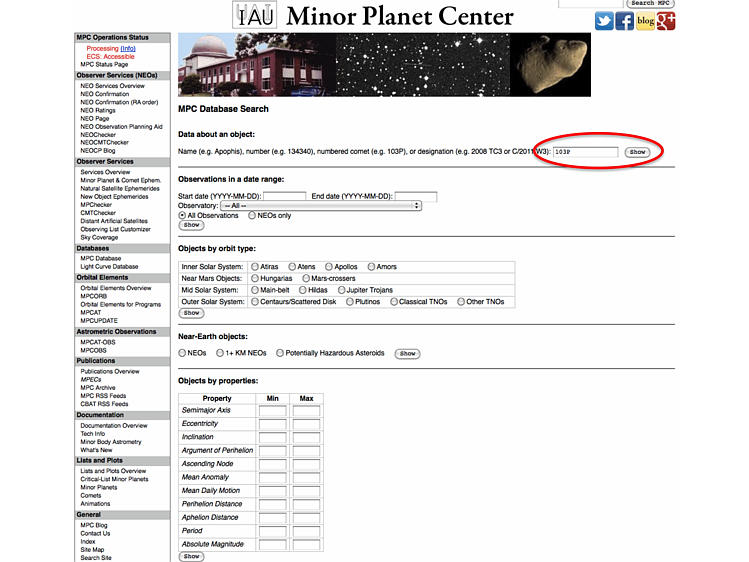 |
| Figure 1A -Example of an MPC query for comet 103P/Hartley 2; the first page. |
- On the page that follows, click the download link (as noted in Figure 1B) and select the observations with C51 in the last column, as shown below in Figure 1C.
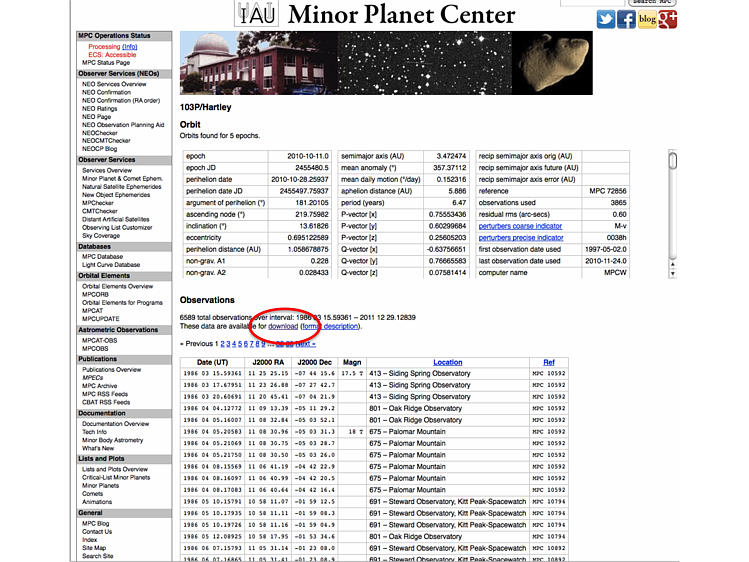 |
| Figure 1B -Example of an MPC query for comet 103P/Hartley 2; the inital query response. Find the download link under the Observations sub heading. |
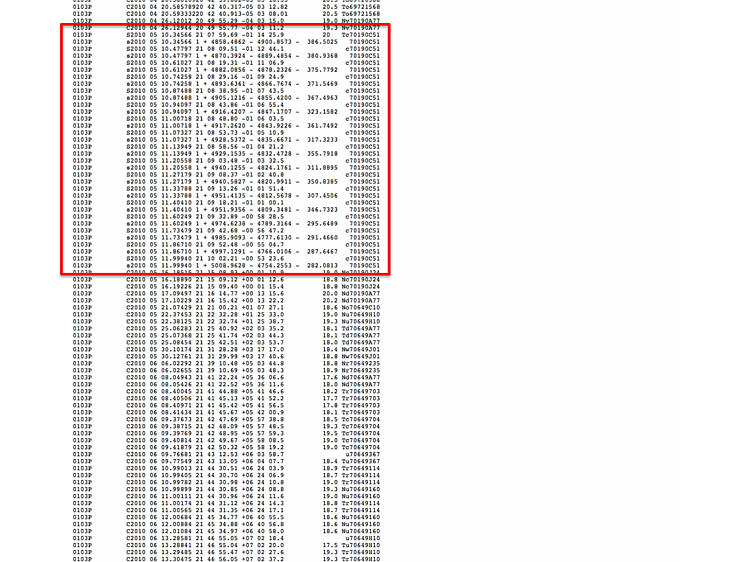 |
| Figure 1C -Example of an MPC query for comet 103P/Hartley 2; the listed observations. Scroll to the desired observations with the WISE observer code, C51, in the last column string. |
Note that the MPC pages will soon include options to filter the observations by observer (e.g. C51), and also note that all entries in this example were for a single epoch, or visit, by the WISE spacecraft. Many objects were viewed at multiple visits, i.e. at two epochs. The link returned the following table mixed in with other observations:
0103P S2010 05 10.34566 21 07 59.69 -01 14 25.9 20 Tc70190C51
0103P s2010 05 10.34566 1 + 4858.4862 - 4900.8573 - 386.5025 70190C51
0103P S2010 05 10.47797 21 08 09.51 -01 12 44.1 c70190C51
0103P s2010 05 10.47797 1 + 4870.3924 - 4889.4854 - 380.9368 70190C51
0103P S2010 05 10.61027 21 08 19.31 -01 11 06.9 c70190C51
0103P s2010 05 10.61027 1 + 4882.0856 - 4878.2326 - 375.7792 70190C51
0103P S2010 05 10.74258 21 08 29.16 -01 09 24.9 c70190C51
0103P s2010 05 10.74258 1 + 4893.6361 - 4866.7674 - 371.5469 70190C51
0103P S2010 05 10.87488 21 08 38.95 -01 07 43.5 c70190C51
0103P s2010 05 10.87488 1 + 4905.1216 - 4855.4200 - 367.4963 70190C51
0103P S2010 05 10.94097 21 08 43.86 -01 06 55.4 c70190C51
0103P s2010 05 10.94097 1 + 4916.4207 - 4847.1707 - 323.1582 70190C51
0103P S2010 05 11.00718 21 08 48.80 -01 06 03.5 c70190C51
0103P s2010 05 11.00718 1 + 4917.2620 - 4843.9226 - 361.7492 70190C51
0103P S2010 05 11.07327 21 08 53.73 -01 05 10.9 c70190C51
0103P s2010 05 11.07327 1 + 4928.5372 - 4835.6671 - 317.3233 70190C51
0103P S2010 05 11.13949 21 08 58.56 -01 04 21.2 c70190C51
0103P s2010 05 11.13949 1 + 4929.1535 - 4832.4728 - 355.7918 70190C51
0103P S2010 05 11.20558 21 09 03.48 -01 03 32.5 c70190C51
0103P s2010 05 11.20558 1 + 4940.1255 - 4824.1761 - 311.8895 70190C51
0103P S2010 05 11.27179 21 09 08.37 -01 02 40.8 c70190C51
0103P s2010 05 11.27179 1 + 4940.5827 - 4820.9911 - 350.8385 70190C51
0103P S2010 05 11.33788 21 09 13.26 -01 01 51.4 c70190C51
0103P s2010 05 11.33788 1 + 4951.4135 - 4812.5678 - 307.4506 70190C51
0103P S2010 05 11.40410 21 09 18.21 -01 01 00.1 c70190C51
0103P s2010 05 11.40410 1 + 4951.9356 - 4809.3481 - 346.7323 70190C51
0103P S2010 05 11.60249 21 09 32.89 -00 58 28.5 c70190C51
0103P s2010 05 11.60249 1 + 4974.6238 - 4789.3164 - 295.6489 70190C51
0103P S2010 05 11.73479 21 09 42.68 -00 56 47.2 c70190C51
0103P s2010 05 11.73479 1 + 4985.9093 - 4777.6130 - 291.4660 70190C51
0103P S2010 05 11.86710 21 09 52.48 -00 55 04.7 c70190C51
0103P s2010 05 11.86710 1 + 4997.1291 - 4766.0106 - 287.6467 70190C51
0103P S2010 05 11.99940 21 10 02.21 -00 53 23.6 c70190C51
0103P s2010 05 11.99940 1 + 5008.9628 - 4754.2553 - 282.0813 70190C51
- Convert the times and RA/Dec positions into an IPAC table with mjd and
positions in decimal degrees:
| mjd| ra| dec|
| double| double| double|
55326.34566 316.99871 -1.24053
55326.47797 317.03963 -1.21225
55326.61027 317.08046 -1.18525
55326.74258 317.12150 -1.15692
55326.87488 317.16229 -1.12875
55326.94097 317.18275 -1.11539
55327.00718 317.20333 -1.10097
55327.07327 317.22388 -1.08636
55327.13949 317.24400 -1.07256
55327.20558 317.26450 -1.05903
55327.27179 317.28487 -1.04467
55327.33788 317.30525 -1.03094
55327.40410 317.32587 -1.01669
55327.60249 317.38704 -0.97458
55327.73479 317.42783 -0.94644
55327.86710 317.46867 -0.91797
55327.99940 317.50921 -0.88989
- Use this table for uploading spatial constraints into the IRSA
General Catalog Query Engine, searching the
WISE All-Sky Single Exposure (L1b) Source Table,
using the Multi-Object Search option. The example
shown here is intended to demonstrate the retrieval of a table of the
object's WISE instrumental photometry values. A reasonable search radius
should be input (for example, between 2 and 10 arcsec). Entering only
positions from the table will return multiple entries, most of which are
unlikely to be associated with the moving object. The user should
limit the time interval of the WISE detection to avoid chance associations,
hence the MJD is required in the table.
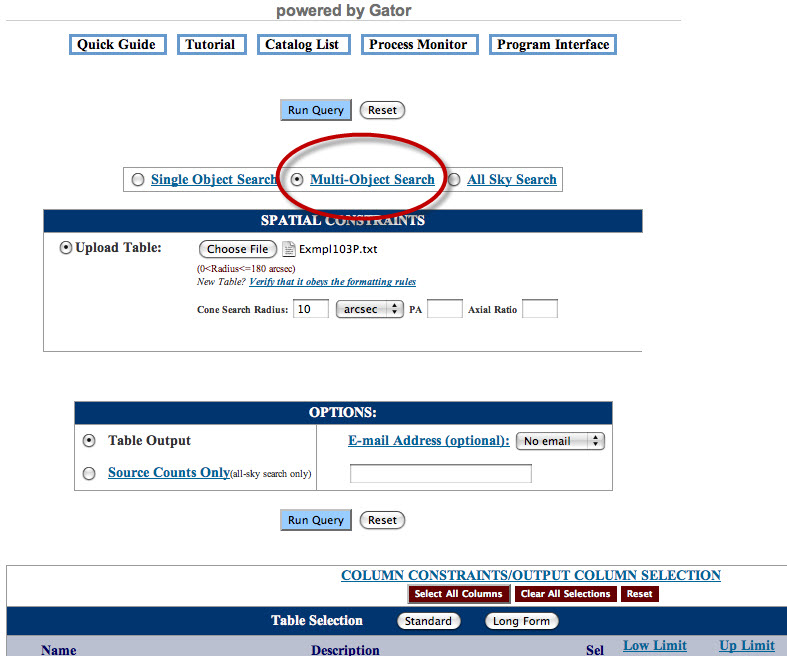 |
| Figure 2 - Example of form-entry box on a typical multi-object IRSA search query of the WISE data, as may be used in the search for a Solar System object. |
- The user should add additional constraints for the time, like "abs(mjd - mjd_01) < 2./86400." in the Additional Constraints (SQL) box at the bottom of the form:
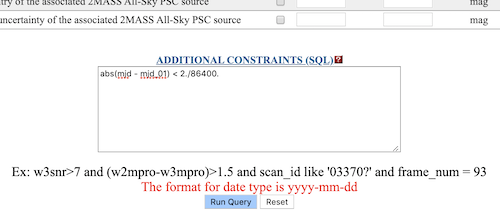 |
| Figure 3 - Example of the Additional Constraints (SQL) box; mjd refers to the query comparison value, while mjd_01 refers to the user's input table value, so that the matches returned are limited to within 2 seconds of the reported MPC observing time. |
The table query will also return an IPAC table in ASCII text as well, upon request. Single-exposure frames and sources from the photometry table can be used to extract images from the IRSA WISE image server.
Each detection is reported in two 80-column lines. The first line provides the astrometric information regarding the object's observation starting with the object's packed designation, time (in YYYY MM DD.DDDDD format, following the "S," which indicates a satellite observation), sky position, in traditional RA and Dec sexagesimal format, estimated apparent magnitude, and observer code (C51 for WISE). The second line contains the previous line's designation and time information followed by the spacecraft position information starting with a unit flag (" 1 ", which indicates distance units of kilometers) followed in turn by separate X, Y and Z vector using the vector from the geocenter to the spacecraft (again, in km) and with respect to the equatorial J2000.0 system. More details on the format may be obtained from the Minor Planet Center . The presently reported tracklets reported to the MPC are from the Pass 1 data processing.
Last update: 2020 February 21










